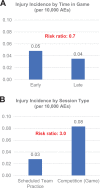Elbow Dislocation and Subluxation Injuries in the National Collegiate Athletic Association, 2009-2010 Through 2013-2014
- PMID: 29372170
- PMCID: PMC5774742
- DOI: 10.1177/2325967117750105
Elbow Dislocation and Subluxation Injuries in the National Collegiate Athletic Association, 2009-2010 Through 2013-2014
Erratum in
-
Corrigendum.Orthop J Sports Med. 2018 Feb 28;6(2):2325967118764935. doi: 10.1177/2325967118764935. eCollection 2018 Feb. Orthop J Sports Med. 2018. PMID: 29512655 Free PMC article.
Abstract
Background: Examination of the incidence of elbow dislocation and subluxation injuries in the collegiate athlete population is limited.
Purpose: To determine the incidence of elbow dislocation and subluxation injuries in the National Collegiate Athletic Association (NCAA) and investigate the risk factors involved.
Study design: Descriptive epidemiology study.
Methods: All elbow subluxation and dislocation injuries from the 2009-2010 through 2013-2014 academic years in the NCAA Injury Surveillance Program database were extracted. The incidence was calculated for different injuries, sports, activity, time in game, competition status, and injury characteristics. Such differences were compared by use of risk ratios to determine risk factors for injury.
Results: The overall incidence of elbow instability injuries was 0.04 per 10,000 athlete-exposures (AEs). Elbow dislocations were more common, with 553 injuries (82.2%, 0.03/10,000 AEs), while elbow subluxations were the minority, with 119 injuries (17.8%, 0.01/10,000 AEs). Men's wrestling had the highest incidence of elbow instability (1.08/10,000 AEs), more than women's gymnastics (0.74), men's football (0.11), and women's volleyball (0.06). All injuries occurred via a contact mechanism, and 99.2% were new injuries. Sixty-nine percent of injuries kept athletes sidelined for more than 2 weeks. Injuries were 3 times more likely to occur in competition (0.08/10,000 AEs) than practice (0.03/10,000 AEs). Injuries sustained during competition were 1.4 times more likely to occur early in the match than late.
Conclusion: Elbow instability injuries are an infrequent but serious source of disability for select NCAA athletes, with a number of associated risk factors. Athletes sustaining these injuries, along with their coaches and medical providers, may benefit from these return-to-play data to best manage expectations and outcomes.
Keywords: NCAA; athletic injuries; database; elbow injuries; elbow instability; epidemiology.
Conflict of interest statement
One or more of the authors has declared the following potential conflict of interest or source of funding: B.D.O. is a paid consultant for ConMed Linvatec, DePuy Synthes, DePuy Mitek, the Musculoskeletal Transplant Foundation, and Rotation Medical and has received institutional research support from Histogenics.
Figures



Similar articles
-
Elbow Injuries in National Collegiate Athletic Association Athletes: A 5-Season Epidemiological Study.Orthop J Sports Med. 2019 Aug 8;7(8):2325967119861959. doi: 10.1177/2325967119861959. eCollection 2019 Aug. Orthop J Sports Med. 2019. PMID: 31448298 Free PMC article.
-
Characteristics of Operative Shoulder Injuries in the National Collegiate Athletic Association, 2009-2010 Through 2013-2014.Orthop J Sports Med. 2018 Aug 16;6(8):2325967118790764. doi: 10.1177/2325967118790764. eCollection 2018 Aug. Orthop J Sports Med. 2018. PMID: 31453202 Free PMC article.
-
Epidemiology of Sports-Related Concussion in NCAA Athletes From 2009-2010 to 2013-2014: Incidence, Recurrence, and Mechanisms.Am J Sports Med. 2015 Nov;43(11):2654-62. doi: 10.1177/0363546515599634. Epub 2015 Sep 1. Am J Sports Med. 2015. PMID: 26330572
-
Epidemiology of Low Back Injuries in National Collegiate Athletic Association (NCAA) Athletes: Results From the NCAA Injury Surveillance Program Between 2009-10 and 2018-19.Am J Sports Med. 2025 Jan;53(1):192-201. doi: 10.1177/03635465241292759. Am J Sports Med. 2025. PMID: 39741476
-
A Sport-specific Analysis of the Epidemiology of Hip Injuries in National Collegiate Athletic Association Athletes From 2009 to 2014.Arthroscopy. 2019 Sep;35(9):2724-2732. doi: 10.1016/j.arthro.2019.03.044. Arthroscopy. 2019. PMID: 31500761
Cited by
-
Elbow Injuries in National Collegiate Athletic Association Football Players: An Epidemiological Study Spanning 5 Academic Years.Orthop J Sports Med. 2019 Sep 6;7(9):2325967119867411. doi: 10.1177/2325967119867411. eCollection 2019 Sep. Orthop J Sports Med. 2019. PMID: 31523691 Free PMC article.
-
Hand and Wrist Injuries Among Collegiate Athletes: The Role of Sex and Competition on Injury Rates and Severity.Orthop J Sports Med. 2020 Dec 15;8(12):2325967120964622. doi: 10.1177/2325967120964622. eCollection 2020 Dec. Orthop J Sports Med. 2020. PMID: 33403205 Free PMC article.
-
Elbow Dislocations in the National Football League: Epidemiology and Management.Cureus. 2021 Nov 3;13(11):e19241. doi: 10.7759/cureus.19241. eCollection 2021 Nov. Cureus. 2021. PMID: 34877218 Free PMC article.
-
Elbow Injuries in National Collegiate Athletic Association Athletes: A 5-Season Epidemiological Study.Orthop J Sports Med. 2019 Aug 8;7(8):2325967119861959. doi: 10.1177/2325967119861959. eCollection 2019 Aug. Orthop J Sports Med. 2019. PMID: 31448298 Free PMC article.
References
LinkOut - more resources
Full Text Sources
Other Literature Sources

